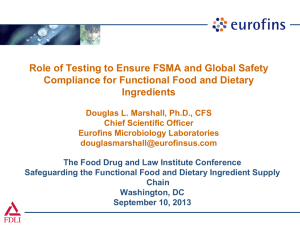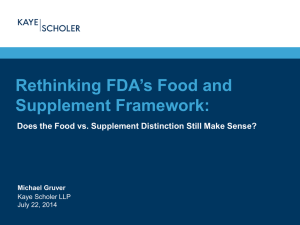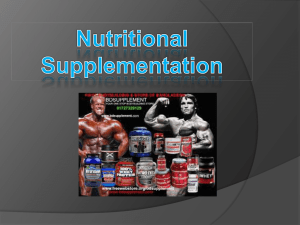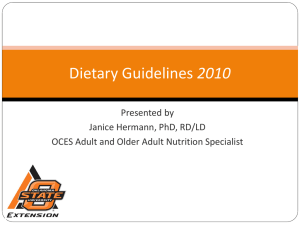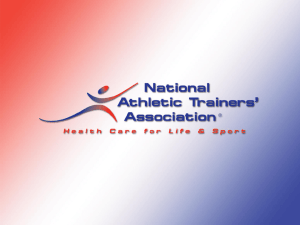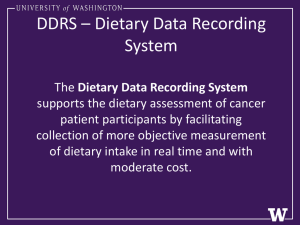Dietary Supplements - Human Performance Resource Center
advertisement
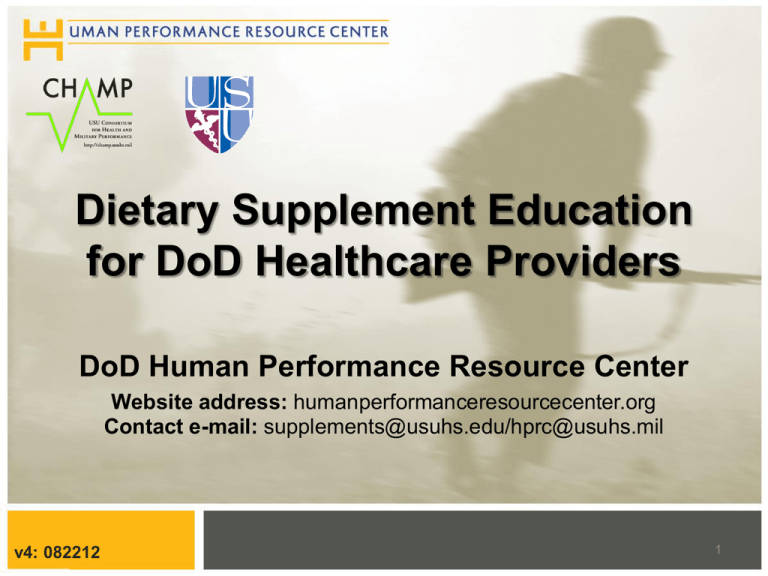
Dietary Supplement Education for DoD Healthcare Providers DoD Human Performance Resource Center Website address: humanperformanceresourcecenter.org Contact e-mail: supplements@usuhs.edu/hprc@usuhs.mil v4: 082212 1 Overview • Introduction • Objectives • Definitions and Regulations • Military Personnel and Supplements • Safety Concerns • Healthcare Providers and Supplements • Finding Science-Based Information 2 Introduction • Military-specific guidelines on how to use dietary supplements (DS) are needed. • Currently, there are no integrated, service-wide policies to guide military personnel on how to use DS safely. • Therefore, the Institute of Medicine (IOM)* recommended that healthcare personnel should be trained to: – Evaluate DS use. – Inform and obtain information from their service members. – Report adverse events through a standardized process. *IOM Report, Use of Dietary Supplements by Military Personnel, 2008 3 Objectives • Define and describe a DS • Explain why military personnel use DS • Explain how DS, as well as medical drugs and food, are regulated • Explain nutritional requirements for service members and identify the contribution of functional foods • Discuss safety concerns associated with DS use • Explain the importance of taking a DS history • Provide science-based resources on DS 4 What is a Dietary Supplement and how is it regulated? 5 What is a Dietary Supplement?* • Product intended to supplement the diet and containing one or more dietary ingredients: – – – – Macronutrients Vitamins, minerals, amino acids Herbs or other botanicals “Other” dietary substances • Intended to be taken by mouth • In the form of a capsule, powder, softgel, gelcap, tablet, liquid, etc. • Not represented for use as conventional food • Labeled as a dietary supplement *Adapted from the U.S. Dietary Supplement Health and Education Act of 1994 6 What is a Botanical? • Plant or plant part valued for its medicinal or therapeutic properties, flavor, and/or scent. • Herbs are a subset of botanicals. Flaxseed Linum usitatissimum St. John’s Wort Hypericum perforatum Soybean Glycine max Thyme Thymus vulgaris 7 Why do Military Personnel Use Dietary Supplements? Demographics Age Gender Duty assignment Education Ethnicity Motivations for use Attitudes Determine the selection of specific products Promote health and prevent illness Enhance physical/cognitive performance Increase strength and stamina Build muscle mass Boost energy Lose weight 8 Regulation of DS, Foods, and Drugs in the United States Food Additives Dietary Supplements Medical Drugs Subject to many laws and regulations closely monitored by the U.S. Department of Agriculture (USDA), the Food and Drug Administration (FDA), and local agencies Subject to limited pre-market review and no pre-market approval Subject to many laws and regulations that are closely monitored by the FDA, Drug Enforcement Agency (DEA), or other agencies Mandatory inspections and incident reports *No formulation standards No product registration No approval of claims Manufacturer responsible for ensuring safety and compliance Mandatory reporting of adverse events Mandatory reporting of adverse events * No formulation standards. However, manufacturers must follow current good manufacturing practices (cGMPs) - 21 CFR Part 111. 9 Regulation of DS in the United States • Under the 1994 Dietary Supplement Health and Education Act (DSHEA), the FDA regulates DS by holding manufacturers accountable in five important areas. Manufacturers are required to: – – – – – Ensure the supplement is safe Make truthful claims Adhere to current Good Manufacturing Practices (cGMPs) Submit all reports of serious adverse events to the FDA Notify the FDA before it markets a supplement containing a “new dietary ingredient” (NDI) 10 Regulation of DS in the United States: Labels • Most closely regulated part of a supplement • Must conform to FDA standards • Requires the following information on labels: – Descriptive name of the product stating it is a "supplement" – Name and place of business of manufacturer, packer, or distributor – Complete list of ingredients – Net contents of the product, e.g., number of pills – *Nutrition labeling (i.e., "Supplement Facts" panel) • Does not have to state the amount of active ingredients *Except for some small-volume products or those produced by eligible small businesses 11 Regulation of DS in the United States: Labels Regulation of DS in the United States: Claims • Claims on Labels – Must be truthful – May not say the DS can be used to prevent, treat, or cure a disease – Must have FDA disclaimer, if it has a structure/function claim: – "This statement has not been evaluated by the FDA. This product is not intended to diagnose, treat, cure, or prevent any disease." • Claims on Brochures – Claims on supplement labels and content of separate brochures and fliers are subject to FDA and Federal Trade Commission (FTC) oversight. Federal Trade Commission (FTC) regulates DS advertising for false and misleading health claims. 13 Regulation of DS in DoD • Generally, if a supplement is not banned or recalled by the FDA, the FTC, or DEA, it is not banned by DoD at large. • DoD has the authority to issue guidance on specific supplements and/or categories of supplements. • Check to see if your unit/command/base has a DS policy in effect. 14 Regulation of DS in the United States: THE BOTTOM LINE • FDA has “post-market” responsibility to ensure compliance with regulations. • DS do not require pre-market approval. • There is no guarantee of quality, purity, composition, safety, or effectiveness of dietary supplements. • Many DS contain banned or harmful substances not declared on the label. 15 Making Informed Decisions on DS Products • RECOMMENDATION: Shop for products with seals from third party/independent verification programs. These programs evaluate and certify DS for quality. Examples are: – – – – United States Pharmacopeia (USP) NSF International Informed-Choice, HFL Sport Science ConsumerLab.com 16 Third-Party Verification Programs CL* HFL Sport Science NSF USP Voluntary Certification Program Informed -Choice NSF/ANSI 173 DS Program DS Verification Program Reviews products for contaminants? Yes Yes Yes Yes Reviews products for quality? Yes Yes Yes Yes Reviews to ensure ingredients are present in quantities specified on label? Yes Yes Yes Yes Reviews labels to ensure they meet FDA specifications? Yes Yes Yes Yes Name of Company Name of program *CL = ConsumerLab.com 17 Third-Party Verification Programs Name of Company CL* HFL Sport Science NSF USP Tests for dissolution and disintegration? Yes No Yes Yes Screens for banned substances? No Yes Yes No Inspects manufacturing facilities for GMP**? No Yes/No*** Yes Yes Conducts random off-the-shelf tests on approved products? No Yes No Yes Provides certification/seal on approved products? Yes Yes Yes Yes Lists evaluated and approved products/brands? Click here for list Click here for list Click here for list Click here for list *CL = ConsumerLab.com **GMP = Good Manufacturing Practice ***Click for additional information 18 Military Personnel and Supplements Balancing Foods and Supplements 20 Warrior Athletes: Nutritional Requirements • Athletes may have an increased need for protein. • Athletes need to maintain hydration by consuming 1 L (~36 oz) of fluid for every 1,000 calories expended. • Athletes can meet their nutritional requirements with foods alone and do not require dietary supplements. • Many Warfighters are like athletes with respect to nutritional needs. 21 Warrior Athletes: Nutritional Requirements Nutrient Recommendations for Athletes Carbohydrates 6 -10 g/kg (2.7-4.5 g/lb) body weight Protein Recommendations vary -Endurance 1.2-1.4 g/kg (0.55-0.64 g/lb) body weight -Resistance (up to 1.7 g/kg (0.8 g/lb) body weight Fat Micronutrients Guidelines for Americans 45 - 65% of calories from carbohydrates 0.8 g/kg ( 0.4 g/lb) body weight 20-25% of calories from 20-35% of calories fat from fat Meet DRIs Function in Exercise Maintains glucose levels Energy metabolism Build and repair muscles Provides energy Co-factors in energy metabolism 22 Nutritional Requirements in Extreme Environments 23 Functional Foods • Category of foods that supposedly provide health benefits beyond basic nutrition. • Have been modified in some way to enhance health (e.g., adding vitamin C to beverages). • FDA-approved health claims may appear on labels (e.g., soy protein may reduce the risk of cardiovascular disease) if scientific evidence supports it. • Currently no specific regulation in the United States. • Examples of functional foods: – – – – – – Juice with added calcium Drinks with botanicals Milk with vitamin D and DHA Breakfast cereals with vitamins and minerals Modified vegetable oils Soy bars 24 Operational Rations: Military Functional Foods • Provide fat, protein, carbohydrates, fiber, and micronutrients (vitamins and minerals). • Nutritional standards for operational rations are based on Military Dietary Reference Intakes (MDRIs). – MDRIs are based on the IOM Dietary Reference Intakes (DRIs). • Dietary supplements cannot be included in rations. • Examples of Military Rations: – – – – – Meal, Ready to Eat (MRE) First Strike Ration Meal, Cold Weather/Food Packet, Long-Range Patrol Light Weight Rations Tailored Operational Training Meal 25 Description of Selected Operational Rations • Meal, Ready to Eat (MRE): standard individual operational rations (3 MREs/day) – Intended to be a Warfighter's sole sustenance for up to 21 days – Meets AR 40-25 on nutritional standards – One MRE provides ~1,250 calories • First Strike Ration (FSR): restricted rations used by Warfighters on extended foot patrols for 3 to 10 days – One FSR has ~2,900 calories – Weighs much less than one MRE 26 Safety Concerns Tainted Dietary Supplements 27 Beware of Tainted DS • Dietary supplements with hidden drugs and chemicals • Potentially dangerous ingredients include: – Approved prescription drug ingredients and their analogs – Drugs banned by the FDA for safety reasons – Controlled substances such as anabolic steroids and stimulant diet drugs – Untested/unstudied new active drug ingredients 28 Health Hazards of Tainted DS • • • • • Contain undeclared ingredients Sometimes 3 or 4 times recommended dose Untested and unstudied ingredients Interactions with other medications Consumers/physicians unaware of possible side effects • Consumer perception that more is better 29 Red Flags to watch for • High-risk category products: – – – – Bodybuilding products Sexual enhancement products Weight-loss products Diabetes products 30 Red Flags to watch for • Claims on labels such as: – “Do not take if you have any medical condition, if you are taking any prescription medications, or if you are pregnant.” – “May cause a positive result in a performance-enhancing drug test.” – An alternative to (or claiming to have similar effects to) an FDA-approved drug—e.g., “All natural alternative to XYZ.” These claims often indicate that the supplement may contain substances not on the ingredients list, prescription drug analogs, or banned substances. 31 Red Flags to watch for • Claims about the supplement curing a wide range of unrelated diseases (e.g., cancer, AIDS, in addition to diabetes) • Labels missing the statement below if supplement claims to affect normal body structure or function (e.g., “helps promote bone health”) – “These statements have not been evaluated by the Food and Drug Administration. This product is not intended to diagnose, treat, cure, or prevent any disease.” • Supplements promising “quick fixes” (e.g., to cure XYZ in seven days, lose weight in nine days, shrink tumors in one week, cure impotency in two weeks, etc.) 32 Red Flags to watch for • Labels that have… – text in a foreign language – directions or warnings that resemble FDA-approved drug products – claims that it is as effective as an FDA-approved drug – inadequate or absent safety warnings – a black-box warning • Supplements not verified by a third-party verification program. Some third-party verification programs are: – United States Pharmacopeia (USP) – NSF International – Informed-Choice, HFL Sport Science – ConsumerLab.com 33 Red Flags to watch for • Solicitations (e-mails) offering products in the high-risk product categories • Directions and warnings that resemble FDAapproved drug products • Inadequate or absent safety warnings • Product marketed with personal testimonials about amazing results from using the product • Products rated 7 or lower by the Natural Medicines Comprehensive Database (NMCD) • The NMCD rates commercial products based on safety, effectiveness, and quality. Each product gets a rating of 1-10 with 10 being the best and 1 being the worst. 34 Red Flags to watch for • Products that contain any of these problematic ingredients… 5-HTP (5-Hydroxytryptophan) Aconite Adrenal extract Aga (Amanita muscaria) Alkanna American mistletoe Apricot kernel Aristolochia Beth Root Bitter Orange (Synephrine) Bittersweet nightshade Bladderwrack Blue Cohosh Blue Flag Butanediol (BD) Buttercup Calamus Calotropis Canadian hemp Catnip Cesium Chaparral Chenopodium oil Clematis Clubmoss Colloidal Silver Coltsfoot Comfrey Country Mallow Coltsfoot Comfrey Country Mallow 35 Red Flags to watch for • Products that contain any of these problematic ingredients… DMAA (1,3 dimethylamylamine) Dolomite Ephedra European mandrake Germanium Gamma-butyrolactone (GBL) GHB (Gamma hydroxybutyrate) Gravel root Greater Celandine Hawaiian baby woodrose Heartleaf (Sida cordofolia) Hemp oil Horny goat weed (Epimedium grandiflorum) Indian snakeroot (Rauwolfia) Jaborandi Jimson weed Kava Laminaria Lobelia Pinellia ternata Salvia (Diviner's sage) Usnea or Usnic acid Vinca rosea (madagascar periwinkle) Wild indigo Yohimbe 36 Additional Safety Concerns • Lack of information – Research studies usually focus on young, healthy individuals (often males) as study subjects • Excess protein intake – Individuals consuming protein shakes, bars, and powders may exceed recommended protein intake • Ephedra/ Synephrine 20 - 25 mg Excess nutrient intake – Many individuals use more than one type of supplement; many of these products are excessively fortified • Stacking Aspirin 80 mg Caffeine 200 mg – Taking multiple ingredients together to increase effects of selected ingredients 37 Additional Safety Concerns • Proprietary Ingredients – Actual ingredients and their amounts are not always provided • Multiple-ingredient products – Some products contain several ingredients, which may or may not be listed on the label 38 Wishful Thinking Common sense tells us that popping a pill alone does not build muscles. In reality, individuals must use skills, disciplined physical training, personal effort, and good nutrition to realize their full potential. 39 Healthcare Providers and Dietary Supplements Asking about DS use and evaluating supplements 40 Healthcare Providers should: • • • • Query service members on supplement use. Document use of specific supplements by patients. Support patient desire to improve performance/health. Educate service members about safety concerns. – Tainted and contaminated supplements – Facts vs. claims • Know where to find relevant research on supplements. • Be on the lookout for possible adverse reactions to supplements and know how to report them. • Be informed on and advise service members about third-party certification programs. 41 Healthcare Providers should ask about DS use • Sample questions: – Do you take any DS in the form of pills, shakes or drinks, powders, bars, sprays, gums, or gels? – Do you take anything to improve your workout or performance? – Do you take anything to increase muscle mass or provide energy? – Do you follow any special practices to enhance your performance? – Do you take any products to improve your health? • Accurate information may not be given in response to general questions. • Response rates may double when you ask specific questions. • Phrasing of questions may determine accuracy of the information. 42 Guidelines for Evaluating DS • • • • • • • • • What is in it? Does label conform to FDA rules? Is it safe? Is it the right stuff? Does it make sense? Does it work? Does it reach its target? What other sources exist? Why take it? 43 Guidelines for Evaluating DS • What is in it? – What does DS contain? Are there multiple ingredients? • Does label conform to FDA rules? – Does product label state that it is a "supplement”? Name and place of manufacturer/packer/distributor? A complete list of ingredients? • Is it the right stuff? – Is the active ingredient of the same quality/quantity as the one used in studies showing effectiveness? 44 Guidelines for Evaluating DS • Is it safe? – Have any adverse effects or concerns been expressed by credible professional organizations? Have long-term studies even been conducted? • Does it make sense? – Is the claim consistent with current knowledge of exercise physiology and nutrition? (Is it biologically plausible?) • Does it work? – What effect does it have on performance and what is the evidence for this? Is the intended use the same as that for which there is evidence? Is the evidence applicable to the general population or just specific groups? 45 Guidelines for Evaluating DS • Does it reach its target? – Are there differences in bioavailability between dietary and supplemental sources? • What other sources exist? – Is this a dietary constituent? If so, how much is ingested and what are the sources? • Why take it? – Supplements cannot compensate for training or overall dietary adequacy. 46 Finding Science-Based Information on Supplement Safety and Effectiveness Creatine: Is it safe? Does it work? 47 Objectives • Describe how to locate evidence-based resources to determine safety and efficacy/effectiveness of supplements. • Provide tools for performing evidence-based searches. • Explain why evidence for reported effects of a supplement applies only to the specific dose and type of user studied. 48 Sample Questions • Is it SAFE to use creatine supplements? • Are creatine supplements EFFECTIVE for increasing muscular strength? 49 Finding Information on DS Safety or Effectiveness Examples of credible resources: – – – – – Human Performance Resource Center Natural Medicines Comprehensive Database Office of Dietary Supplements U.S. Food and Drug Administration PubMed Search Engines – Google Scholar – WorldCat 50 Strategies for a Search • Search for published government guidelines. • If none are available, search for systematic reviews and reliable review articles. – Systematic reviews provide a summary of available research on a given topic. • If reviews are not found, perform a literature search for published, peer-reviewed materials to ensure quality and plausibility. – Randomized controlled clinical trials are the highest level of evidence. • Remember: Findings cannot be extrapolated to other uses, doses, populations, outcomes, etc. 51 DoD Dietary Supplement Classification System • Classifies DS for DoD service members based on expected risk and potential benefit • Located at: – http://hprc-online.org/dietary-supplements/dietary-supplementclassification-system-1#.UDP8no4Qh5g – Accompanying monographs contain information on: – Dose range/upper limit – Potential benefits – Military performance and survivability – Medication interactions – Withdrawal effects – And more… 52 Benefit Dietary Supplement Risk Matrix Safety < Minimal Concern Low Concern Moderate Concern High Concern High Potential 1 2 7 9 Moderate Potential 3 4 8 10 Low Potential 5 6 11 12 53 Summary • DS cannot offset the unfavorable effects of poor food choices. • Be an informed consumer and know: – – – – How DS are regulated. What third-party verification programs are. Potential safety concerns and health hazards. Which DS product categories are high risk. • Use reliable science-based resources to stay informed. 54 References and Resources • Arsenault J, Kennedy J. Dietary supplement use in U.S. Army Special Operations candidates. Mil Med. 1999;164:495-501. • Athlete Advisory - Methylhexaneamine and Dietary Supplements • Athlete Guide to the 2011 Prohibited List • Human Performance Resource Center • IOM (Institute of Medicine). 2008. Use of dietary supplements by military personnel. Washington, DC: The National Academies Press. • Lieberman HR, Stavinoha T, McGraw S, White A, Hadden L, and Marriott B. Use of dietary supplements among active duty US Army soldiers. Am J Clin Nutr. 2010;92(4):985-995. • Natural Medicines Comprehensive Database • Nutrition Standards and Education. Army Regulation 40–25 BUMEDINST 10110.6. AFI 44-141. • Office of Dietary Supplements • U.S. Food and Drug Administration 55

